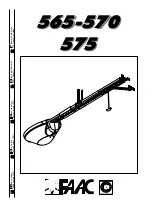
GB
Retain these installation, operating and maintenance instructions for the full duration of the operator’s service life!
19
• Programming the operator
Control elements
A
a.
B
C
D
Before programming
Menu stage 1: Programming the start
function for the hand transmitter
Menu stage 2: Programming the light
function for the hand transmitter
The controls for programming the door operator are
protected by a transparent cover. The transparent
cover can be opened with a screwdriver. After the
operator has been programmed, the transparent
cover must be closed again.
. Numerical display shows the menu stage as well
as the selected value.
Point display, lights up to indicate “ready for
operation” and flashes on the hand transmitter
code learning completion.
. Button
during the setting / adjustment phase
serves as an “up” button and outside the menu as
a start button.
. Button
during the setting /adjustment phase
serves as a “down” button.
. Button
is used to call up the setting/adjustment
menu, to change the menu stages and to store the
settings.
The programming of the control unit is menu-driven.
By pressing button
, the menu guide is called up.
The numbers displayed indicate the menu stage.
After approx. 2 seconds, the display flashes and the
setting can be altered via buttons
and
. The
selected setting is stored with button
. And the
programme jumps automatically to the next menu
stage. By repeatedly pressing button
, menu
stages can be skipped. To quit the menu, press
button
until “0” is shown again. Outside the menu,
button
can be used to generate a start impulse.
- Allow door to engage into the carriage.
- Pull out the mains plug. Point display (a) lights up.
- Make sure that the aerial is correctly positioned
(see figure 13).
- Observe the hand transmitter instructions.
Briefly press button
. “1” is displayed. As soon as
the display flashes, press and keep pressed for
approx. 1 second the button of the hand transmitter,
with which you later wish to start the operator. As
soon as the code has been read, the red point
display (a) flashes four times before quitting.
Further hand transmitters (up to a maximum of 30)
can be programmed.
Deleating all the hand transmitters programmed
for the operator:
Menu stage 3: Setting/adjusting the top end-
of-travel position
Plug in the operator‘s main plug while pressing
button
.
Keep button
pressed for 3 seconds. Number 3
appears in the display 8 a.
Wait a short while until the 3 starts flashing.
Press button
and make sure that the door travels in
the OPEN direction.
If the door closes in the wrong direction, after
having pressed
, keep button
pressed for
another 3 seconds. “3” flashes briefly. The
!
Figure
0 will be displayed. Menu finished.
Press key
briefly and figure 1 will be displayed.
Press key
once again and figure 2 will be
displayed.
Press the second button at the transmitter with which
the 4-min light is to be switched on. As soon as the
code has been read in, the red point display (a) will
flash four times to acknowledge the entry. Figure 0
will be displayed. Menu finished.
14
15
16
17
travelling direction is altered.
Now travel by pressing button
into the desired door
end position OPEN 17b.
By pressing button
, the position can be corrected
into direction CLOSE.
Once the desired OPEN end-of-travel position has
been reached, press button
. The operator stores
the OPEN end-of-travel position and “4” appears in
the display.
We recommend setting the suitable door type in
menu stage 8 prior to the force-learning cycle.
During this opening and closing cycle, the
operator learns the force required to open and close
the door.
The cycles
must not be interrupted. During these cycles must
not be interrupted. During these cycles “0” appears
in the display.
- Press button . The operator causes the door to
open until the top end-of-travel position has been
reached.
- Now press button
again. The operator causes
the door to close until the bottom end-of-travel
position has been reached.
- After approx. 2 seconds, “0”disappears.
If the force setting is too high, persons may
be placed at risk of injury.
The factory setting is 4!
- Place an obstruction (e. g. operator’s cardboard
box) underneath the doors’s closing edge.
- Starting from the OPEN end-of-travel position,
actuate the door to close.
- The door travels towards the obstruction, stops
and travels back to the top end-of-travel position.
If the door springs have been changed or altered,
then the force learning cycle must be repeated:
proceed to menu stage 5 and keep button
pressed for 3 seconds. “0” appears in the display.
Then complete the force learning cycle as explained
under point 19.
After approx. 2 seconds, the display flashes showing
the set value of the opening force limit. The force limit
Menu stage 4: Setting/adjusting the bottom
end-of-travel position
Wait a short while until “4” starts flashing.
Press button
. The operator causes the door to
travel in the CLOSE direction as long as the button is
pressed. The position can be altered to the OPEN
direction via button ..
Once the desired CLOSE end-of-travel position has
been reached, press button
. The operator stores
the CLOSE end-of-travel position and “0” appears in
the display.
Force-learning cycle
Caution!
Checking the force limit facility
Menu stage 5: The opening force limit
!
A force limit does not apply!
• Special settings
In order to access the menus for the special settings,
keep key
pressed for 3 sec until figure 3 is
displayed. Press key
to by-pass menu step 3.
Now keep key
pressed for 3 sec until figure 5 is
displayed. Press key
to by-pass menu steps.
18
19
20
setting can be increased or decreased via buttons
and . After setting the value, press button
.
The display shows “6”.
After approx. 2 seconds, the display starts flashing,
and the set value for the closing force limit is
displayed.
The force limit setting can be increased or decreased
via buttons
and .
After setting the value, press button
. “0” appears
in the display.
Finally, check the force settings, and, if necessary,
repeat the setting procedure.
The maximum force at the main closing edge must
not exceed 150 N!
Keep button
pressed again for 3 seconds until
“7” appears in the display.
Menu
Light
Warning
Flashing
value
phase
phase
function
0
60 s
-
-
1
120 s
-
-
2
240 s
-
-
3
0 s
0 s
yes
4
0 s
3 s
-
5
0 s
0 s
-
6
0 s
3 s
yes
7
90 s
3 s
-
8
90 s
3 s
yes
9
0 s
10 s
yes
The factory setting is 1.
Press button
. “8” appears in the display.
1
15
0
15
0
4
25
30
25
40
5
15
15
15
55
6
15
15
15
15
7
35
35
65
45
8
55
15
15
100
The factory setting of 4 must be adhered. The
softruns may only be alerted on the express per-
mission of the door manufacturer.
Press button
. “0” appears in the display.
Menu stage 6: The closing force limit
Menu stage 7: Light phases
Menu stage 8: Door fitting
Important note:
Menu
Start
Stop
Start
Stop
value
open
open
closed
closed
9
only soft run
These values correspond to the “soft” runs
measured in cm at the carriage.
When the advance warning time is set, the light will
flash before the operator starts running.
0
0
0
0
0
2
0
15
0
40
3
15
15
15
35
Summary of Contents for DC 650 T
Page 1: ...DC 650 T DC 800 T WN 923013 04 6 50 05 13...
Page 3: ...11 11 iso 20 10 6 3 x 16 5a a X a X 10 10 13 1a 1 8 x 16 13 2 4 17 5b 1 13 2 3e...
Page 4: ...13 8 7 11 11 4 12 max 45 13 8 9 9 13 10 a b a 7 12...
Page 6: ...A a C B D 14 3 sec 14 5x 5x 19b 19a 17c 17b 18b 16b 16a 17a 18a 15a 15b 15c F F 400N 50mm 20...
































